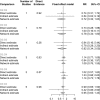Should the flexibility enabled by performing a day-4 embryo transfer remain as a valid option in the IVF laboratory? A systematic review and network meta-analysis
- PMID: 31111304
- PMCID: PMC6603118
- DOI: 10.1007/s10815-019-01475-0
Should the flexibility enabled by performing a day-4 embryo transfer remain as a valid option in the IVF laboratory? A systematic review and network meta-analysis
Abstract
Purpose: The present systematic review and network meta-analysis aims to uniquely bring to literature data supporting the true place of the alternative practice of day-4 embryo transfer (D4 ET) in an IVF laboratory, beyond the one-dimensional option of facilitating a highly demanding program.
Methods: A systematic search was conducted in the databases of PubMed/Medline, Embase, and Cochrane Central Library, resulting to six prospective along with nine retrospective cohort studies meeting eligibility criteria for inclusion. A comparison of D4 ET with day-2 (D2), day-3 (D3), and day-5 (D5) ET, respectively, was performed employing R statistics.
Results: The sourced results indicate no statistically significant difference regarding clinical pregnancy rates, and ongoing pregnancy/live birth rates stemming from the comparison of D4 with D2, D4 with D3, and D4 with D5 ET, respectively. Additionally, no statistically significant difference could be established in respect to cancelation, and miscarriage rates, following the comparison of D4 with D3 and D4 with D5 ET. Interestingly, we report statistically significant lower preterm birth rates associated with D4 ET, in contrast with D5 ET (RR, 0.19; 95% CI, 0.05-0.67; p value = 0.01).
Conclusions: The aforementioned results may serve as advocates buttressing the option of D4 ET as a valid candidate in the ET decision-making process. Possible limitations of the current study are the publication bias stemming from the retrospective nature of certain included studies, along with various deviations among studies' design, referring to number and quality of transferred embryos, or different culture conditions referring to studies of previous decades.
Keywords: Blastocyst; Cleavage embryo; Clinical pregnancy; Day of embryo transfer; Embryo transfer; Morula.
Conflict of interest statement
The authors declare that they have no conflict of interest.
Figures









Similar articles
-
Day three versus day two embryo transfer following in vitro fertilization or intracytoplasmic sperm injection.Cochrane Database Syst Rev. 2016 Dec 14;12(12):CD004378. doi: 10.1002/14651858.CD004378.pub3. Cochrane Database Syst Rev. 2016. PMID: 27976360 Free PMC article.
-
Application of seminal plasma to female genital tract prior to embryo transfer in assisted reproductive technology cycles (IVF, ICSI and frozen embryo transfer).Cochrane Database Syst Rev. 2018 Feb 28;2(2):CD011809. doi: 10.1002/14651858.CD011809.pub2. Cochrane Database Syst Rev. 2018. PMID: 29489026 Free PMC article.
-
Cleavage-stage versus blastocyst-stage embryo transfer in assisted reproductive technology.Cochrane Database Syst Rev. 2022 May 19;5(5):CD002118. doi: 10.1002/14651858.CD002118.pub6. Cochrane Database Syst Rev. 2022. PMID: 35588094 Free PMC article.
-
Cleavage stage versus blastocyst stage embryo transfer in assisted reproductive technology.Cochrane Database Syst Rev. 2016 Jun 30;(6):CD002118. doi: 10.1002/14651858.CD002118.pub5. Cochrane Database Syst Rev. 2016. Update in: Cochrane Database Syst Rev. 2022 May 19;5:CD002118. doi: 10.1002/14651858.CD002118.pub6. PMID: 27357126 Updated.
-
Intrauterine administration of human chorionic gonadotropin (hCG) for subfertile women undergoing assisted reproduction.Cochrane Database Syst Rev. 2016 May 20;(5):CD011537. doi: 10.1002/14651858.CD011537.pub2. Cochrane Database Syst Rev. 2016. Update in: Cochrane Database Syst Rev. 2018 Oct 20;10:CD011537. doi: 10.1002/14651858.CD011537.pub3. PMID: 27195724 Updated.
Cited by
-
When the Embryo Meets the Endometrium: Identifying the Features Required for Successful Embryo Implantation.Int J Mol Sci. 2024 Feb 29;25(5):2834. doi: 10.3390/ijms25052834. Int J Mol Sci. 2024. PMID: 38474081 Free PMC article. Review.
-
Embryo Transfer Procedural Parameters Do Not Predict IVF Cycle Outcome.J Clin Med. 2024 Feb 26;13(5):1312. doi: 10.3390/jcm13051312. J Clin Med. 2024. PMID: 38592155 Free PMC article.
-
Comparison of pregnancy outcomes between 4th day morula and 5th day blastocyst after embryo transfer: a retrospective cohort study.BMC Pregnancy Childbirth. 2024 Jul 3;24(1):458. doi: 10.1186/s12884-024-06597-7. BMC Pregnancy Childbirth. 2024. PMID: 38961359 Free PMC article.
-
Multivariate analysis of the factors associated with live births during in vitro fertilisation in Southeast Asia: a cross-sectional study of 104,015 in vitro fertilisation records in Taiwan.J Assist Reprod Genet. 2021 Sep;38(9):2415-2423. doi: 10.1007/s10815-021-02086-4. Epub 2021 Jun 1. J Assist Reprod Genet. 2021. PMID: 34075516 Free PMC article.
-
Day 4 Versus Day 5 Fresh Embryo Transfer in In Vitro Fertilization: Is It All About Timing?J Clin Med. 2025 Jun 28;14(13):4596. doi: 10.3390/jcm14134596. J Clin Med. 2025. PMID: 40648969 Free PMC article.
References
Publication types
MeSH terms
LinkOut - more resources
Full Text Sources
Medical

